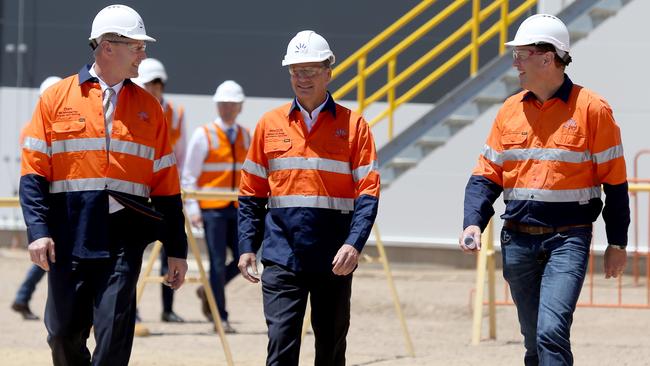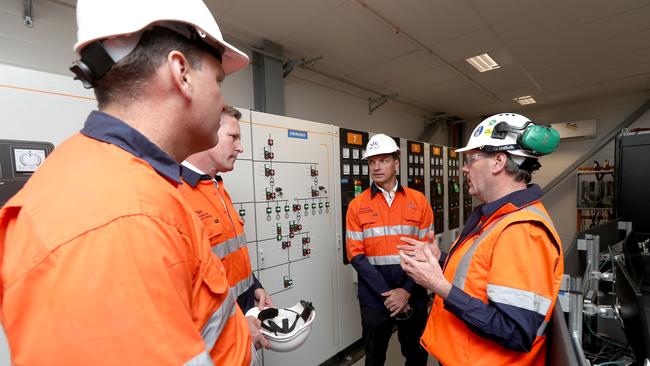AGL’s Barker Inlet gas power station on Torrens Island begins operation, set to lower prices
A new $295 million gas power plant — the first in seven years — has begun operating in Adelaide and is expected to stabilise supply and lower prices. SEE THE VIDEO
SA News
Don't miss out on the headlines from SA News. Followed categories will be added to My News.
A new $295 million gas-fired power station which has begun operating in Adelaide will help reduce electricity prices, owner AGL and the State and Federal Governments say.
“AGL’s new power station will provide more affordable, reliable and cleaner energy for South Australian homes and businesses,” AGL chief executive Brett Redman said on Monday.
The Barker Inlet station, the first gas plant built for the National Electricity Market since 2012, will replace part of the company’s Torrens Island plant which is due for closure next year after 50 years of operation.
“This power station is highly efficient, with generating units capable of operating at full capacity within five minutes of starting,” Mr Redman said, adding that Torrens Island would take at least 12 hours to operate fully.
“This is important, because it will allow us to provide a rapid response to changes in renewable generation supply and demand – particularly wind generation here in SA.
“This is something not capable from older coal and gas power stations.”

Mr Redman said AGL could guarantee supply to customers by blending its renewable energy with output from the gas plant.
This meant they could sell energy at about $75/MWh, even though the gas component would be more expensive.
That wholesale price would be below SA’s average of $110/MWh in 2018-19.
Mr Redman did not specify how much price relief would be felt by households but said the downward pressure on prices would begin immediately the plant was commissioned.
The 210MW Barker Inlet Power Station comprises 12 reciprocating engines and it is 28 per cent more efficient than Torrens Island — and “therefore produces 28 per cent less carbon dioxide.”

The plant, built by a construction workforce of about 400, will operate as a peaking plant, running only when demand requires.
On a weekday, SA’s grid demand is typically around 1500MW but doubles to 3000MW in the late afternoon on really hot days.
Federal Energy and Emissions Reduction Minister Angus Taylor said the plant will improve the reliability of the South Australian grid.
“The Barker Inlet Power Station will ensure South Australians have access to increased firm generation that will lower prices and increase supply,” he said.
Mr Taylor said Australia was seeing “record, world-leading levels of investment in renewables” but these needed to be complemented by generators such as Barker Inlet.
“That is absolutely essential to ensure we’ve got affordable, reliable power on the worst days and that there’s downward pressure on prices when there are shortages of supply,” he said.
Mr Taylor also praised the SA Government for “doing the right thing” with its energy policies.
SA Energy and Mining Minister Dan van Holst Pellekaan said Barker Inlet would work “in harmony with renewable energy”.
“More renewable energy will be able to be used in SA when we have this type of fantastic new technology,” he said.

Both Mr Taylor and Mr van Holst Pellekaan said the forthcoming summer season would be tight in meeting demand and avoiding blackouts — but they were optimistic SA and Victoria would scrape by.
Mr Redman said part of its Loy Yang coal-fired power station in Victoria which has been out of action will be repaired by December 16.
The outage at Loy Yang and at part of Origin’s gas-fired plant in Mortlake have increased risk fears for summer.
However, AGL asked for an extension to shore up supply this summer for Victoria and SA.
The State Government granted approval last month for it to operate until March.
Torrens Island Power Station B continues to operate.
Prior to Barker Inlet, the most recent gas-fired plant in the market was the $810 million Mortlake Power Station built by Origin in western Victoria and opened in August 2012.
The former SA Government leased then purchased nine dual-fuel generators but did not operate them in the market.
These generators will be leased to Infigen Energy and Nexif from May next year, when they will be able to participate in the market.
